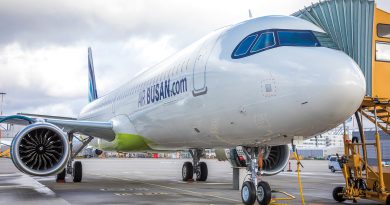Play, Pause, Rewind
A look at the some of the dynamics of the wireless and seatback IFE landscapes
United Airlines’ recent financial results are indicative of an industry enjoying positive demand trends for air travel.
For the full year 2024, the airline operated the most flights and carried the most passengers in its history as customers reacted positively to the carrier’s ongoing investment in technology and the travel experience executed under its United Next plan. United Next is the company’s long-term strategy to position the airline as a leading carrier, right sized with fleet flexibility and ‘revolutionising the experience of flying United’ with a vastly improved customer experience standard that places a premium on the overall comfort of flying.
This includes the agreement with SpaceX to bring Starlink’s Wi-Fi service to more than 1,000 of the airline’s mainline and regional aircraft, providing members of its loyalty programme MileagePlus free, fast, reliable internet connectivity on some passenger flights as soon as Spring 2025.
Additionally, the airline has surpassed 300 new and retrofit aircraft in 2024 featuring United’s signature interior with bigger bins, seatback screens at every seat and Bluetooth connectivity, resulting in a 4.5 point improvement in customer satisfaction with inflight entertainment.
Delta’s commitment to evolving the in-flight entertainment experience is also paying dividends. According to the carrier, two years of fast, free Wi-Fi has reinforced what the airline knew to be true when it went “all-in” on free Wi-Fi and seatback screens: connectivity and entertainment are more valued than ever, with customers that are increasingly digital savvy and seeking personalised experiences.
“Delta is constantly listening to our customers and evolving to meet their needs,” said Julieta McCurry, VP of In-Flight Entertainment and Connectivity. “We know they want an in-flight experience similar to what they have at home, including more ways to engage and stay entertained.”
Delta Sync is Delta’s personalisation brand accessed through membership of its frequent flyer programme, SkyMiles. Launched in 2023, it currently comprises Delta Sync Wi-Fi and Delta Sync Seatback.
Delta Sync Wi-Fi is transitioning from Intelsat system technology to Viasat for high-speed connectivity onboard domestic mainline routes (with the exception of the 74 aircraft in Delta’s Boeing 717 fleet) and international-serving widebody fleets, and Hughes for streaming-capable connectivity to Delta’s fleet of more than 400 regional jets as well as to the Boeing 717 fleet. In partnership with Hughes, Delta is exploring a connectivity solution that will enable simultaneous multi-network connectivity, expected to fly onboard in late 2025, providing more reliable streaming to personal devices and more stable performance across Delta’s global network.
Coinciding with celebrations marking its centenary year, Delta is collaborating with Thales Avionics, to introduce a next-generation Delta Sync seatback experience onboard beginning with select new aircraft deliveries starting in 2026.
The forthcoming enhanced Delta Sync seatback is powered by FlytEDGE the first cloud-native IFE system. Features of the new system include an intelligent 4K HDR QLED display, offering a high-contrast, theatre-like viewing with over 1 billion vibrant colours, Bluetooth capabilities so passengers can pair their wireless devices, and Thales’ Onboard Data Center (ODC) with 96TB of storage, – over fifty times the average Delta IFE system capacity – to enable edge caching, bringing immense volumes of content and instant streaming experiences to passengers.
Seatback survival
It wasn’t that long ago that doomsday sayers were predicting the demise of the seatback screen, but as Andy Masson, Vice President Product & Portfolio Management at Panasonic says, the market has changed quite a bit over the last few years.
He explains that with the advent of personal electronic devices (PEDs) there was a big question mark over whether airlines were going to continue to install seat back IFE.
“Some airlines in certain regions never put IFE in, typically, because they were short haul flights. And the reality was the system was not cheap or particularly light, so, there was a penalty to pay for it,” he says. “But some of the challenges of the past have quelled a little bit: the IFE solutions today are considerably lighter weight, so they’re easier to install on aircraft.
“The challenges around Head Impact Compliance (HIC) and certification, with our latest generation of seatback [Astrova] has largely been quelled because it’s so good, it performs so well.”
In conversation with Aerospace Innovations, Masson reveals that Panasonic has seen its revenue income from the wired seatback solutions exponentially increase. “More and more airlines are looking at seatback and I think what that is doing is creating a market force differential between the airlines that don’t have it and do have it that’s been recognised in ticket sales. So, you’re seeing it is differential in passenger experience and expectation. And I think what that’s now then doing is creating in those regional markets a more focused approach toward the seatback. We’re seeing it becoming more of a hygiene factor.”
Panasonic’s next-generation Astrova IFE platform is its fastest adopted IFE solution with 70 airline program commitments in just two years since launch. As Masson alludes, this equates to over 250,000 screens across 1,000 aircraft. Summing up, Masson says Astrova is the company’s lightest system with the best technology. Additionally, it’s both modular and updatable, which was never previously the case. “So, it answers all the questions that the market was asking,” he confers.
Staying connected
Supporting its IFE portfolio is Panasonic’s connectivity services. As Masson says, “I think it’s very rare to have Panasonic connectivity and someone else’s entertainment system. If you have a connectivity system with us, you almost certainly sit in front of one of our seatbacks, like 99% of these, but we do offer our entertainment system with other connectivity systems.”
Over recent years, the company has invested in enhancing its inflight connectivity (IFC) service with a substantial expansion of its global connectivity network. For example, in 2023, Panasonic added new HTS (High Throughput Satellites) and XTS (Extreme Throughput Satellites) capacity over North, Central, and South America, Europe, the Middle East, the Arabian Sea, Africa, and the Indian Ocean. The satellites also cover both the North and South Atlantic Ocean. It also extended its capabilities in Asia with additional HTS capacity over China and Japan.
The company is also advancing plans to launch multi-orbit connectivity services, incorporating an electrically steered antenna (ESA) capable of accessing a combination of GEO and LEO (low earth orbit) satellites. To facilitate this, it has signed a multi-year collaboration with Kognitive Networks to integrate secure multi-channel aggregation technology into its IFC services.
Wireless attraction
Wireless (or streaming) IFE is ideal as a standalone solution as well as being a great compliment to seatback for airlines that want to provide a more robust IFE experience.
Panasonic has had a wireless solution, eXW, for quite some time. As Ken Sain, Chief Executive Officer of Panasonic Avionics Corporation has previously commented, “Wireless IFE remains a critical component of many airlines’ strategy.” He says eXW can create a unique experience that combines passenger entertainment, digital apps, and onboard retail into a truly unique passenger experience with a competitive total cost of ownership and a compelling ROI.
AirFi’s portable wireless IFE solution is classed as carry-on equipment, so no STC or further paperwork is required. Job Heimerikx, CEO of AirFi explains that, “The boxes have an impressive battery life, and we also offer a semi-embedded solution whereby a small cradle is installed into the overhead bin that connects the box to aircraft power. Our box is fully automated, taking cues from the aircrafts ADS-B signal so crew don’t need to worry about turning the system on or off at the correct altitude. Given that 99% of passengers now carry Wi-Fi enabled devices with them onboard, wireless IFE is a solution that everybody can use and that airlines can deploy rapidly with little capital investment.”
According to Heimerikx there are around 1,300 aircraft worldwide utilising the AirFi IFE solution daily, with a similar number of aircraft operating the company’s mobile point-of-sale solution.
“As a bonus, our W-IFE solution forms the backbone of our connected crew and LEO connectivity solutions, so building upon a great entertainment experience with digital inflight retailing and instant messaging is very easy,” says Heimerikx.
LEO is a lightweight and drag-free system thanks to AirFi’s innovative window-mounted antenna.
Speaking to Aerospace Innovations, Heimerikx says that from an obvious (and wholly passenger-centric) perspective, activating LEO enhances the W-IFE experience by giving passengers the ability to send and receive text-based messages from work, friends or family. From a less-obvious perspective, the passengers’ shopping experience onboard (which is tightly integrated with entertainment content as part of a “Mall in the Sky”) can be enhanced in other ways.
“LEO enables online card payment validation, which gives airlines the confidence to sell more valuable items onboard,” he explains. “Where before the fear of payment fraud limited the scope of inflight retail programs, now airlines can add more attractive and higher value items to the inflight selection. As well, airlines can utilise LEO connectivity to check inventory of third-party offerings like hotel rooms and car rentals. LEO’s IP connection means that if airlines want to offer such items through the streaming IFE system, transactions can be completed and confirmed inflight, and the passenger can receive confirmation of their booking.”
While these benefits improve the passenger experience, Heimerikx says the key benefit for airlines is operational. “LEO enables real-time communication with the ground, which means that crew can communicate with maintenance teams and catering units to speed restocks and repairs for faster turn times.
“Add this to reducing fraud and missed payments, which significantly boosts onboard ancillary revenues, and you can begin to see why it makes perfect sense.”
According to the company, AirFi LEO was contracted for installation on 50 aircraft by Q1 2024 and these installations, plus a variety of expansions and new airlines that have since been added, are ongoing. More than half of the installations under contact have now been completed. “There have been a few delays, mainly tied to paperwork holdups administrative reasons than anything else,” admits Heimerikx. “Any new technology will have teething issues with implementation, so this was expected. We’re encouraged by how quickly these issues have been resolved and rollouts are now accelerating. We expect to complete LEO installations on our first 50-60 aircraft before the second half of the year.”
Heimerikx says that AirFi does not push or require all wireless IFE customers to adopt LEO, but that they are seeing keen interest in the product from existing and new customers alike. “We designed LEO around providing true value to airlines and people can easily see this. Rather than enforcing technology, AirFi focuses on meeting the unique needs of each airline. We see ourselves as providers of a unique toolbox, allowing airlines to choose the solutions and tools that best serve them.”
To help airlines in their choice further, AirFi is advancing its hardware with keen eye to creating and improving solutions to be profitable for the airline. “We develop hardware entirely in-house, ensuring full control over technology stack and enabling continuous innovation. Looking ahead, 2025 will be a significant year with the launch of AirFi’s new-generation portable streaming box in the second half of the year. The “Jupiter Box” on from our first- and second-generation boxes, known as “Venus Box” and “Mars Box”, respectively.
“In the shorter term, we’re working on a new application for LEO that we think is going to delight everyone – but that’s all we can say about that now!” Heimerikx teases.
Bluetooth benefits
One technology offering airlines an alternative to traditional inflight connectivity services is Bluetooth.
According to Ron Chapman, Chairman and President of ASIP Tech, the industry’s focus has predominantly been on broadband Wi-Fi, largely due to the demand for video streaming. He believes that as a result, proposing Bluetooth as a solution can seem unconventional. “Airlines often struggle to embrace this concept initially, and shifting industry perspectives is inherently challenging,” he observes.
Integrating a Bluetooth network allows airlines to connect all passengers, including crew members, using only narrowband and a single access point. This approach simplifies installation and reduces equipment costs, as traditional Wi-Fi systems typically require at least two access points and broadband connectivity to achieve similar coverage.
Chapman says that the appeal of the company’s fflya solution lies in its proven, ultra-low-cost platform that not only offsets installation expenses but also generates new revenue streams while addressing key operational challenges for airlines.
“On short-haul flights, live streaming isn’t essential, as passengers often bring their own content,” says Chapman. “Eliminating the need for streaming reduces data requirements to short bursts—such as texts, telemetry, and credit card transactions—which are well-suited for Bluetooth.”
As Chapman explains, fflya is designed to keep passengers within the airline’s booking app. Notably, major airlines like Delta and United now require passengers to download their apps for free connectivity.
“We provide self-contained PODs for each module, which are integrated into the airline’s app. Our Bluetooth messaging functions similarly to an eSIM but is accessible exclusively through the airline’s app.
“All our modules aim to create marketing and revenue opportunities for airlines by retaining passengers within the airline’s ecosystem. Our efficient Bluetooth network and algorithms result in minimal data costs per transaction. Additionally, our custom gateways offer real-time access to every flight, enabling live promotions and advertising control to boost in-app sales.
“Unlike Wi-Fi, where passengers gain unrestricted internet access and airlines lose marketing opportunities, fflya engages the audience by keeping them within the airline’s-controlled environment. Offering free Wi-Fi often means paying to provide passengers access to external platforms, leading to missed revenue opportunities—a counterintuitive approach given the captive audience onboard.”
This is a point picked up by Masson, who argues that with W-IFE, the airline is reliant on a passenger to bring along their own device. “When that happens, they’re typically going outside of the airline’s environment. If you’re an airline and you have a digital presence, you want, ideally to keep your passengers inside your digital environment.” Panasonic characterises the digital channel through three channels: airline website, airline app (both pre-flight environments) and the onboard IFE system.
Walled garden
“If you have your own solution, you have a way out of the airline’s digital environment. If you bring a tablet or a smart phone on board, more often than not, you’re going to have your own content or content provision that you’re bringing with you,” says Masson. “Or if you sign up to the connectivity solutions, and they’re getting better and better all the time, you’re again putting yourself outside of the airline’s environment.” Passengers may then visit apps like YouTube or Netflix, and access their library of download or purchased content.
“That’s the differential between the wireless environment and the seat back environment. When you’re in the seat back environment, then the airline can get you with targeted digital advertising, and they will make significant ancillary revenue from that, particularly if they can personalise that to your persona. If you’re in their application, and you’re in their website, and they know you as a traveller, a business traveller, and you’re going from London to LA and they can build a persona around you. At that point, if you log into your seat, log in to get extra amenities, or you want extra miles or something, they can then target you with specific advertising. We see this on pre roll videos. And that’s where the beauty of the seatback comes in for the airlines: it’s not just a way of increasing digital engagement.”
A notable development that may elevate Bluetooth’s prominence is Ryanair’s creation of a Bluetooth Order to Seat feature within their app, “a concept we’ve advocated for years and previously tested on Wizz Air,” says Chapman. “In early 2023, we introduced “BOB” (Bluetooth On Board), intending to deploy the Bluetooth network without Satcom initially. It’s encouraging to see this concept gaining traction.” Over the past year, Chapman says they’ve observed a shift in interest, with multiple programs currently undergoing various stages of evaluation with seven different airlines.
Regarding Wizz Air, Chapman says his team completed initial passenger trials on six of Wizz Air UK’s A321ceo aircraft. Wizz Air planned to issue an RFI for fleet-wide implementation; however, challenges related to NEO engine issues led to the relocation of the fflya equipped ceo aircraft to the EU and Dubai, pausing the program. Tens of thousands of passengers downloaded and used the app, averaging 15 messages per passenger—70% via WhatsApp, 29% SMS, and 1% email—aligning with Wizz Air’s demographic.
“We are optimistic that once these issues are resolved, live connectivity will return to Wizz Air’s agenda. Thanks to our collaboration with Wizz Air, we also conducted a live flight test of in-app payment and lab integration with Teledyne’s AID. These are critical operational aspects, as achieving 100% coverage for live payments necessitates a roof antenna, and managing live AID data via Satcom is crucial to avoid unexpected costs.”
In 2024, ASIP introduced its custom-designed second-generation Iridium Certus100 airline module, recently commissioned on a Boeing 767. This advancement is significant claims Chapman, as in addition to free messaging, it now supports three interfaces for live payments (in-app, EPOS, and content server) plus AID and incorporates cockpit voice capabilities with a CVR interface, thereby expanding support for crew operations.
Whatever camp in you’re in, seatback or W-IFE, with the support of inflight connectivity airlines can open huge revenue streams, and more importantly engender passenger loyalty.
By Alexander Preston




